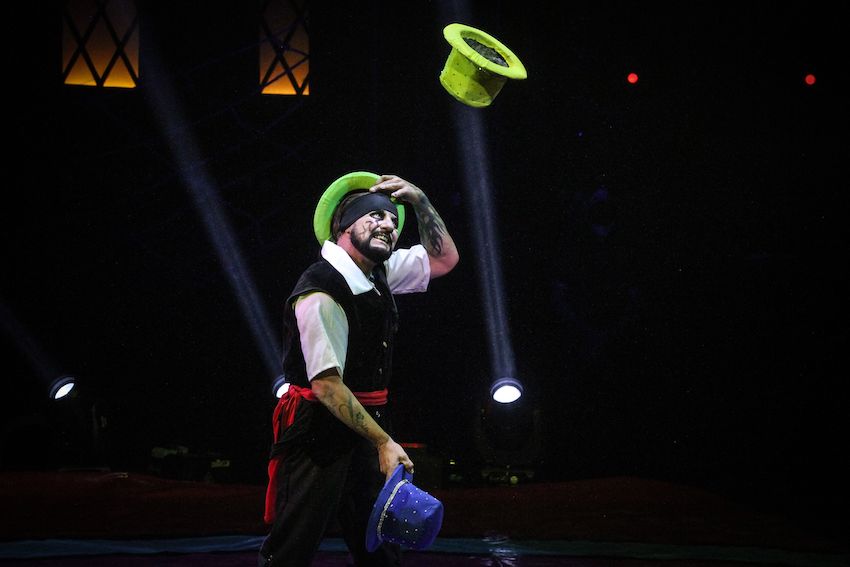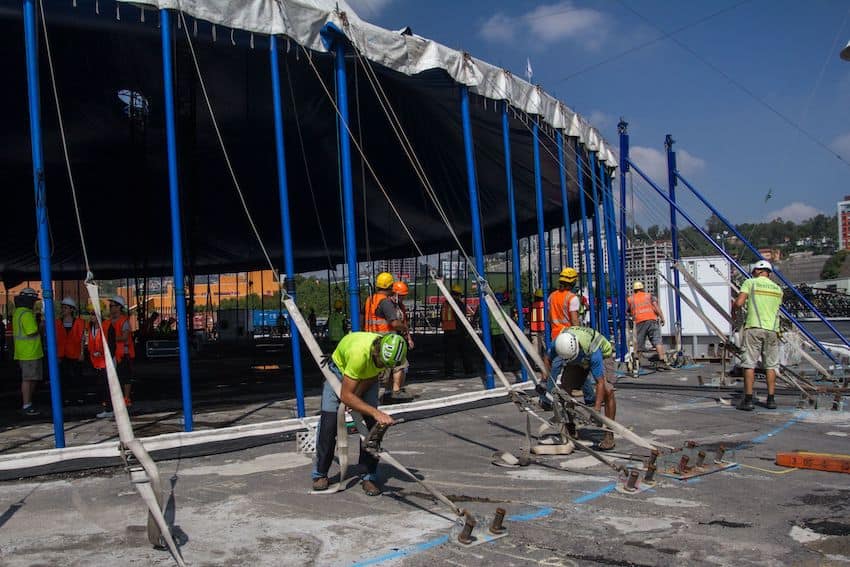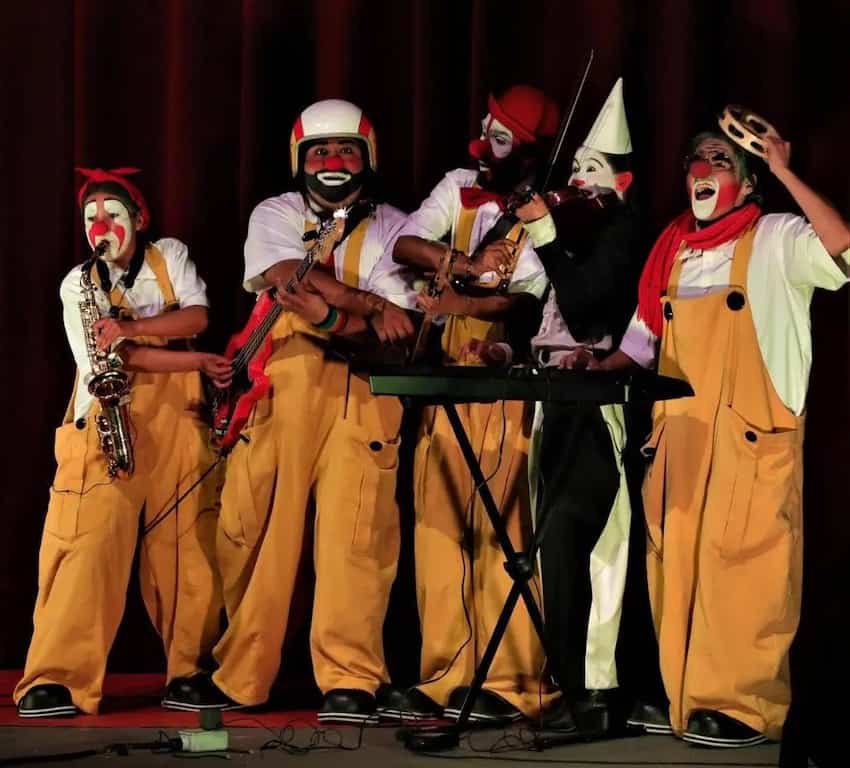Mexico’s circuses, or carpas, got their start in the pre-Hispanic era

It’s summertime and the circus – or if you’re in Mexico, la carpa – is coming to town! Many of us remember our excitement at going to the Ringling Brothers and Barnum & Bailey Circus from our childhood. Mexican children feel that same excitement when they see the trucks of a traveling carpa — a big tent circus — pull into their town.
The concept of the Mexican carpa began in pre-Hispanic times. According to University of Houston historian Nicolas Kanellos, it evolved from a combination of the acrobatic religious ritual of voladores documented by Hernán Cortés’ chronicler Bernal Díaz del Castillo and the circus-like diversions at the court of Mexica Emperor Montezuma, which included dwarfs and a type of clown.
Both voladores and clowns later became part of secular Mexican circus acts. Voladores are flyers who descend like birds from a high revolving platform while another acrobat dances on the top platform, playing a flute and a small drum. The rope attached to the flyers is called a maroma. Appropriately, the early mestizo circus was called compañía de voladores or la maroma.
The Spanish introduced roving minstrels and jugglers to this early entertainment. By 1670, maromeras — circus acrobats — had begun performing at bullfights in Mexico City. By 1769, a clown called el loco de los toros emerged at bullfights and rodeos — an early predecessor of the rodeo clown seen in the United States.
By 1785, the first compañía de voladores was staged in a theater in Mexico City, including actors in musical and dramatic performances. In 1792, the Mexican circus troupe Compañía de Volantines del País brought in additional talent, including La Romántica, a balancing act; a clown dressed as a woman dancing the Jarabe (Mexican hat dance) and sleight-of-hand artists.
Originally based in Mexico City, the circus replaced the “theater of the rich” for many poorer Mexicans. In the 1800s, the traveling carpas became quite popular in northern Mexico. Many family-owned carpas began at ranches as a mix of rodeo and circus acts to raise money to sustain the family during hard times.

The presence of Mexican circuses in Texas was first recorded in the San Antonio Ledger newspaper in 1852. By this point, the circuses had introduced elements from circuses in other countries, including the English clown with baggy pants and a red wig.
San Antonio became the hub for big-top circuses and carpas, which offered entertainment in the poor rural areas of South Texas. Two well-known circus troupes — Teatro Carpa Independencia and Carpa García — made San Antonio their home base.
The carpas were very popular with working-class Mexicans in Texas, combining traditional circus performances with theatrical presentations. They were a mix of clowns and pantomime, singing and dancing, comedy routines and dramatic monologues. They also introduced stock characters like the pelado (the underdog), who engaged in comedic sketches of political and social satire.
The pelado symbolized tejanos’ struggles with discrimination and acculturation. Two notable pelados were Don Slico (Mr. Slick) and El Bato Suave (The Smooth Guy).
During the Great Depression, the small, family-based carpas outlasted many of the larger, more established circuses because their tickets were priced to accommodate poorer Mexicans. At a time of great hardship in the United States, they gave their audiences a temporary escape – the chance to take their minds off their problems for a while – and offered an understanding of their daily struggles through humor.
The Atayde Hermanos Circus is the longest living circus in Mexico. Founded by Aurelio Atayde Guizar and his brothers in Zacatecas in 1888, it started with a childhood dream: Atayde ran away to work in a traveling circus. After years of learning the business, he returned and started his own circus troupe with his brothers.

Their early performances were under a tent erected in the street that became the center of social and political activity, providing not just entertainment but a place to meet.
Performances were attended by Mexican historical figures such as Francisco “Pancho” Villa, Venustiano Carranza, Álvaro Obregón and Elias Calles. In 1909, Francisco Madero held a political meeting of revolutionaries under the circus tent.
The Atayde Hermanos Circus was eventually moved to the Arena Mexico and later to the Palacio de los Deportes in Mexico City. Members traveled the world, entertaining audiences in Central and South America, Europe and the United States. In October 1998, in a nine-day run, they entertained more than 30,000 spectators in the Los Angeles Memorial Sports Arena in California.
After 126 years of touring, the Atayde Hermanos Circus closed down in 2014, facing dwindling revenues and a citywide ban on the use of animals in circus acts in Mexico City. However, it recently reopened.
Perhaps the most famous Mexican circus is the Hermanos Vázquez — a contemporary mix of Mexican and American circus elements. It was founded in 1969 by the brothers José Guillermo and Rafael Vázquez and is based in Mexico City.
Israel González of the Kaylicoas circus family became their star attraction. An accomplished tightrope walker and acrobat, his most famous act was known as the “Human Volcano.”

In this act, González is submerged in a glass cylinder, holding his breath while gasoline is poured on top of the water above him and set on fire. The exact same quantity of gasoline is used for every performance so González knows how long to hold his breath to allow the fire to extinguish.
The Hermanos Vázquez Circus is still performing in Mexico City.
The circus is a timeless institution that continues to endure, thrilling audiences young and old — the excitement of watching the big striped tent being erected while acrobats practice their highwire acts and back flips; the perpetual flow of music; clowns walking around getting into character for the upcoming performance.
But beneath the glamor and seduction of the circus is a very hardscrabble life. Filmmaker Aaron Schock’s visually poetic documentary “Circo” reveals the financial difficulties and strain on the Ponce family as they struggle to carry on the family tradition. Unfortunately, the number of family-owned carpas is dwindling – and many may soon take down their tents for the last time.
But it’s not too late yet. To find out when a circus is coming to your area go to CircusFansMéxico.
Sheryl Losser is a former public relations executive and professional researcher. She spent 45 years in national politics in the United States. She moved to Mazatlán in 2021 and works part-time doing freelance research and writing.
Source: Mexico News Daily

